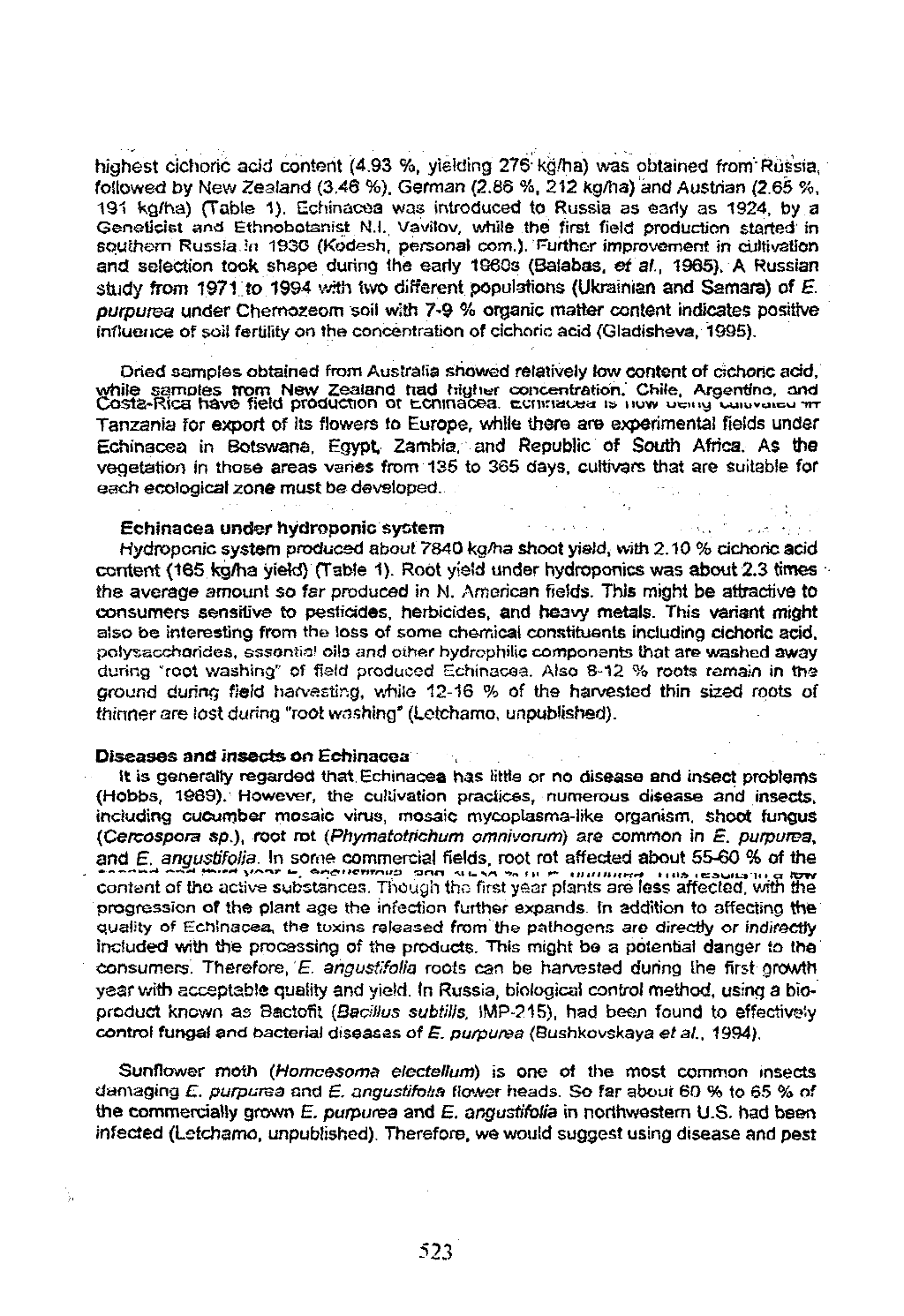

highest cichoric add content (4.93 %, yielding 276-kg/ha) was obtained from' Russia,
followed by New Zealand (3.46 %), German (2*86
%,
212 kg/ha) and Austrian (2.65 %,
191 kg/ha) (Table 1). Echinacea was introduced to Russia as early as 1924, by a
Geneticist and Ethnobotanist NT Vavilov, while the first field production started in
s o u th e r n
Russia
In
1930 (Kodesh, personal com.), further improvement in cultivation
and selection took shape during the early 1G60s (Salabas,
et at,
1965). A Russian
study
from 1971 to 1994 with two different populations (Ukrainian
and Samara)
of E.
purpurea
under Chemozeom soil with 7-9
%
organic matter content indicates positive
influence of soil fertility on the concentration of cichoric acid (Gladisheva, 1995).
Dried samples obtained from Australia showed relatively low content of cichoric add,
while samoles trom New Zealand had higher concentration. Chile,
Argentine,
and
Costa-Rica have field production ot tcninacea. tcnmausci »» itow uoi
-nx
Tanzania for export of Its flowers to Europe, while there are experimental fields under
Echinacea in Botswana, Egypt Zambia, and Republic of South Africa. As the
vegetation in those areas varies from 135 to 365 days, cultivars that are suitable for
each ecological zone must be developed.
Echinacea under hydroponic system
Hydroponic system produced about 7840 kg/ha shoot yield, with 2.10 % cichoric acid
content (165 kg/ha yield) (Table 1). Root yield under hydroponics was about 2.3 times
the average amount so far produced in N. American fields. This might be attractive to
consumers sensitive to pesticides, herbicides, and heavy metals. This variant might
also be interesting from the loss of some chemical constituents including cichoric acid,
polysaccharides, essential oils and other hydrophilic components that are washed away
during "root washing’ of field produced Echinacea. Aiso 8-12 % roots remain in the
ground during field harvesting, while 12-16 % of the harvested thin sized roots of
thinner are lost during "root washing*' (Letchamo, unpublished).
D iseases and insects on Echinacea
It is generally regarded that Echinacea has little or no disease and insect problems
(Hobbs, 1989). However, the cultivation practices, numerous disease and insects,
including cucumber mosaic virus, mosaic mycoplasma-like organism, shoot fungus
(Cercospora sp.), root rat
(Phymafotrichum omn'tvorum) are common
in £.
purpurea,
and
E
angustifolia.
In some commercial fields, root rot affected about
55-60
% of the
-------------------- ‘ * * -•'-*
« - 'i 't w n w i i a а п п ч и ч л -V. fi tt u l a . c i u u n . a
txrrv
content of the active substances.
Though the first
year plants are less affected, with the
progression of the plant age the infection further expands, in addition to affecting the
quality
of
Echinacea,
the
toxins
released from the pathogens
are
directly or indirectly
included with the processing of the products. This might be a potential danger to the
consumers. Therefore, E.
angustifolia
roots can be harvested during the first growth
year with acceptable quality and yield. In Russia, biological control method, using a bio
product known as Saciofit
{Bacillus subtifis,
IMP-215), had been found to effectively
control fungal and bacterial diseases of E.
purpurea
(Bushkovskaya
et
a i
. 1994).
Sunflower moth
(Homcesoma efecteUum)
is one of the most common insects
damaging E.
purpurea
and E
angustifoha
flower heads. So far about 60 % to 65
% of
the commercially grown £.
purpurea
and E.
angustifolia
in northwestern U.S. had been
infected (Letchamo, unpublished). Therefore, we would suggest using disease and pest
Научная электронная библиотека ЦНСХБ









